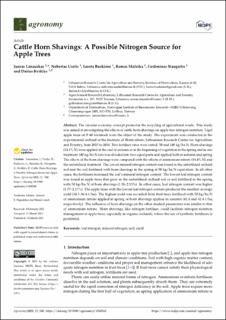| dc.contributor.author | Lanauskas, Juozas | |
| dc.contributor.author | Uselis, Nobertas | |
| dc.contributor.author | Buskiene, Loreta | |
| dc.contributor.author | Mazeika, Romas | |
| dc.contributor.author | Staugaitis, Gediminas | |
| dc.contributor.author | Kviklys, Darius | |
| dc.date.accessioned | 2021-07-06T07:57:53Z | |
| dc.date.available | 2021-07-06T07:57:53Z | |
| dc.date.created | 2021-04-27T07:59:49Z | |
| dc.date.issued | 2021-03-12 | |
| dc.identifier.citation | Agronomy. 2021, 11 (3), . | en_US |
| dc.identifier.issn | 2073-4395 | |
| dc.identifier.uri | https://hdl.handle.net/11250/2763490 | |
| dc.description.abstract | The circular economy concept promotes the recycling of agricultural waste. This study was aimed at investigating the effects of cattle horn shavings on apple tree nitrogen nutrition. Ligol apple trees on P 60 rootstock were the object of the study. The experiment was conducted in the experimental orchard of the Institute of Horticulture, Lithuanian Research Centre for Agriculture and Forestry, from 2015 to 2018. Two fertiliser rates were tested: 50 and 100 kg/ha N. Horn shavings (14.1% N) were applied at the end of autumn or at the beginning of vegetation in the spring and in one treatment 100 kg/ha N rate was divided into two equal parts and applied both in autumn and spring. The effects of the horn shavings were compared with the effects of ammonium nitrate (34.4% N) and the unfertilised treatment. The lowest mineral nitrogen content was found in the unfertilised orchard soil and the soil fertilised with horn shavings in the spring at 50 kg/ha N equivalent. In all other cases, the fertilisers increased the soil’s mineral nitrogen content. The lowest leaf nitrogen content was found in apple trees that grew in the unfertilised orchard soil or soil fertilised in the spring with 50 kg/ha N of horn shavings (1.58–2.13%). In other cases, leaf nitrogen content was higher (1.77–2.17%). The apple trees with the lowest leaf nitrogen content produced the smallest average yield (34.5–36.6 t/ha). The highest yield was recorded from fruit trees fertilised with 50 kg/ha N of ammonium nitrate applied in spring or horn shavings applied in autumn (42.4 and 41.4 t/ha, respectively). The influence of horn shavings on the other studied parameters was similar to that of ammonium nitrate. Horn shavings, like nitrogen fertiliser, could facilitate nitrogen nutrition management in apple trees, especially in organic orchards, where the use of synthetic fertilisers is prohibited. | en_US |
| dc.language.iso | eng | en_US |
| dc.publisher | MDPI, Basel, Switzerland | en_US |
| dc.rights | Navngivelse 4.0 Internasjonal | * |
| dc.rights.uri | http://creativecommons.org/licenses/by/4.0/deed.no | * |
| dc.title | Cattle Horn Shavings: A Possible Nitrogen Source for Apple Trees | en_US |
| dc.type | Peer reviewed | en_US |
| dc.type | Journal article | en_US |
| dc.description.version | publishedVersion | en_US |
| dc.rights.holder | © 2021 by the authors | en_US |
| dc.source.pagenumber | 12 | en_US |
| dc.source.volume | 11 | en_US |
| dc.source.journal | Agronomy | en_US |
| dc.source.issue | 3 | en_US |
| dc.identifier.doi | 10.3390/agronomy11030540 | |
| dc.identifier.cristin | 1906585 | |
| dc.source.articlenumber | 540 | en_US |
| cristin.ispublished | true | |
| cristin.fulltext | original | |
| cristin.qualitycode | 1 | |

